Analyzing Facebook's Effectiveness as a Business Communication Tool
VerifiedAdded on 2022/08/21
|12
|2656
|14
Annotated Bibliography
AI Summary
This annotated bibliography examines the role of Facebook as a business communication tool, drawing on a range of scholarly articles to assess its impact on small and medium enterprises (SMEs). The bibliography includes sources from credible scholars, focusing on how Facebook facilitates marketing, enhances brand awareness, and influences consumer behavior. Key themes explored include the effectiveness of Facebook advertising, the development of marketing communication models, and strategies for engaging customers. The sources highlight the importance of creating attractive and relevant content, utilizing social media for brand building, and understanding the emotional responses of users. The research emphasizes that a strong Facebook presence can lead to increased sales, improved customer relationships, and a competitive edge for businesses. The bibliography also provides insights into the cost-effectiveness of Facebook marketing, highlighting its accessibility and potential for reaching a large customer base. The findings demonstrate that by using the right messages through social media, businesses can influence consumption and improve their performance.
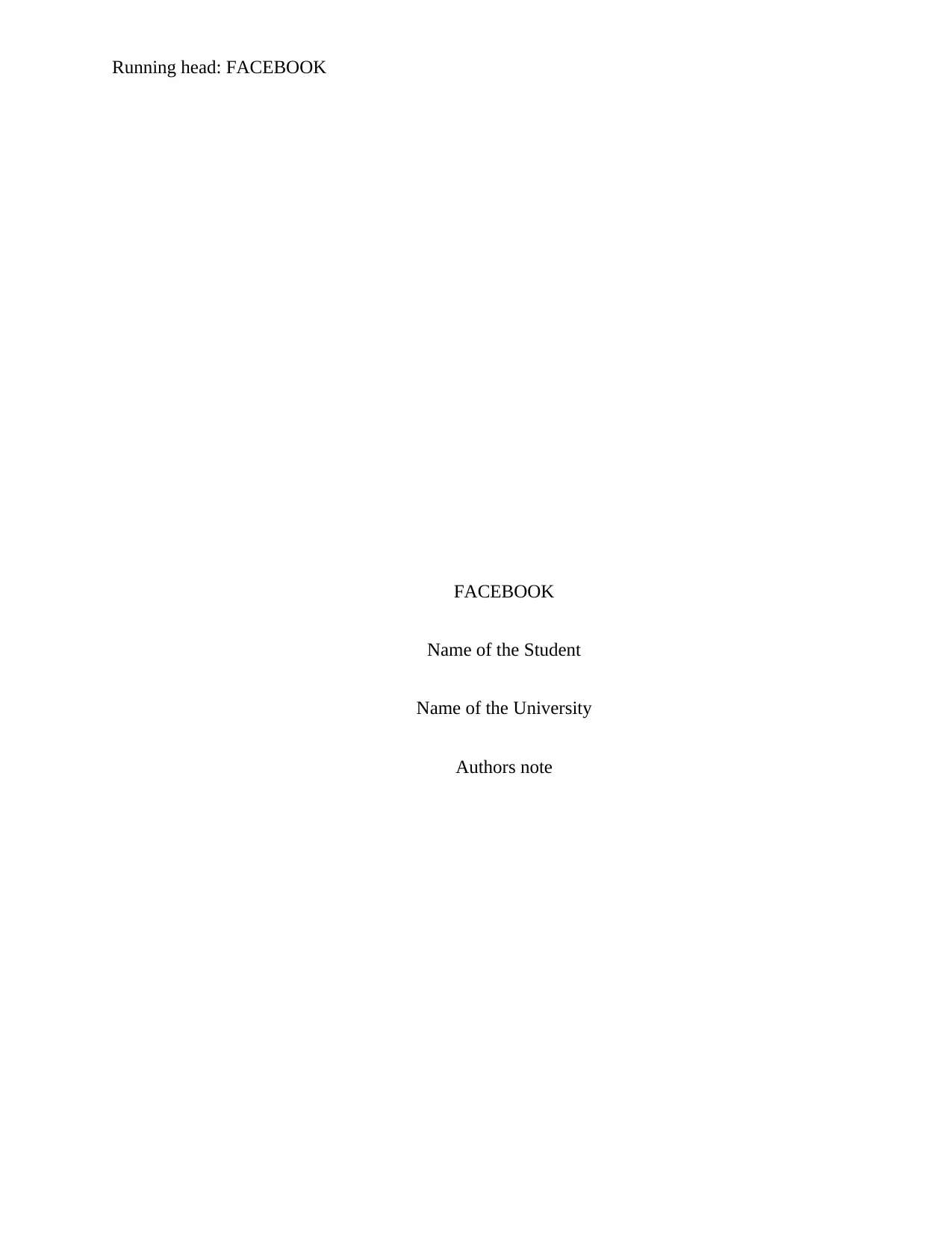
Running head: FACEBOOK
FACEBOOK
Name of the Student
Name of the University
Authors note
Name of the Student
Name of the University
Authors note
Paraphrase This Document
Need a fresh take? Get an instant paraphrase of this document with our AI Paraphraser
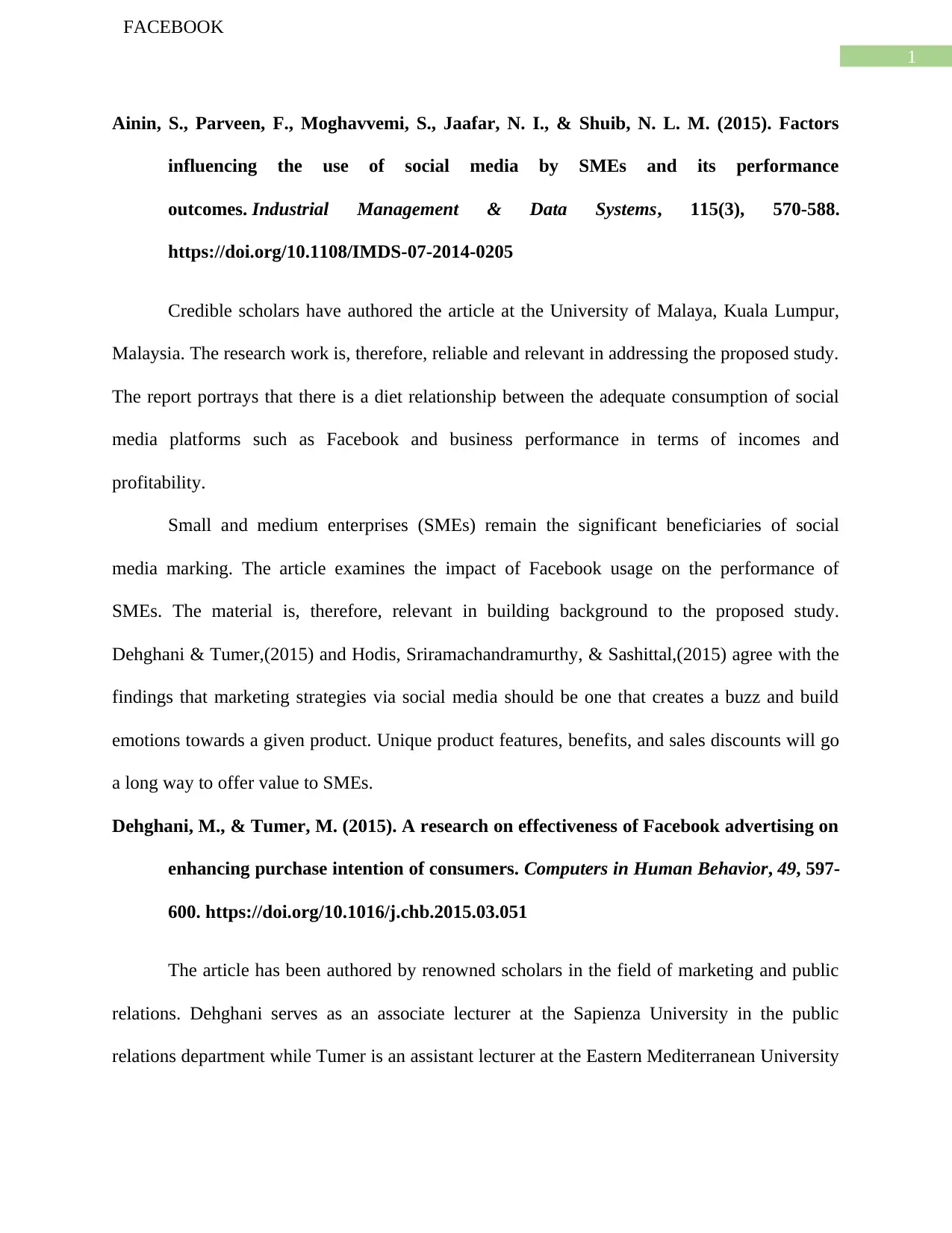
1
FACEBOOK
Ainin, S., Parveen, F., Moghavvemi, S., Jaafar, N. I., & Shuib, N. L. M. (2015). Factors
influencing the use of social media by SMEs and its performance
outcomes. Industrial Management & Data Systems, 115(3), 570-588.
https://doi.org/10.1108/IMDS-07-2014-0205
Credible scholars have authored the article at the University of Malaya, Kuala Lumpur,
Malaysia. The research work is, therefore, reliable and relevant in addressing the proposed study.
The report portrays that there is a diet relationship between the adequate consumption of social
media platforms such as Facebook and business performance in terms of incomes and
profitability.
Small and medium enterprises (SMEs) remain the significant beneficiaries of social
media marking. The article examines the impact of Facebook usage on the performance of
SMEs. The material is, therefore, relevant in building background to the proposed study.
Dehghani & Tumer,(2015) and Hodis, Sriramachandramurthy, & Sashittal,(2015) agree with the
findings that marketing strategies via social media should be one that creates a buzz and build
emotions towards a given product. Unique product features, benefits, and sales discounts will go
a long way to offer value to SMEs.
Dehghani, M., & Tumer, M. (2015). A research on effectiveness of Facebook advertising on
enhancing purchase intention of consumers. Computers in Human Behavior, 49, 597-
600. https://doi.org/10.1016/j.chb.2015.03.051
The article has been authored by renowned scholars in the field of marketing and public
relations. Dehghani serves as an associate lecturer at the Sapienza University in the public
relations department while Tumer is an assistant lecturer at the Eastern Mediterranean University
Ainin, S., Parveen, F., Moghavvemi, S., Jaafar, N. I., & Shuib, N. L. M. (2015). Factors
influencing the use of social media by SMEs and its performance
outcomes. Industrial Management & Data Systems, 115(3), 570-588.
https://doi.org/10.1108/IMDS-07-2014-0205
Credible scholars have authored the article at the University of Malaya, Kuala Lumpur,
Malaysia. The research work is, therefore, reliable and relevant in addressing the proposed study.
The report portrays that there is a diet relationship between the adequate consumption of social
media platforms such as Facebook and business performance in terms of incomes and
profitability.
Small and medium enterprises (SMEs) remain the significant beneficiaries of social
media marking. The article examines the impact of Facebook usage on the performance of
SMEs. The material is, therefore, relevant in building background to the proposed study.
Dehghani & Tumer,(2015) and Hodis, Sriramachandramurthy, & Sashittal,(2015) agree with the
findings that marketing strategies via social media should be one that creates a buzz and build
emotions towards a given product. Unique product features, benefits, and sales discounts will go
a long way to offer value to SMEs.
Dehghani, M., & Tumer, M. (2015). A research on effectiveness of Facebook advertising on
enhancing purchase intention of consumers. Computers in Human Behavior, 49, 597-
600. https://doi.org/10.1016/j.chb.2015.03.051
The article has been authored by renowned scholars in the field of marketing and public
relations. Dehghani serves as an associate lecturer at the Sapienza University in the public
relations department while Tumer is an assistant lecturer at the Eastern Mediterranean University
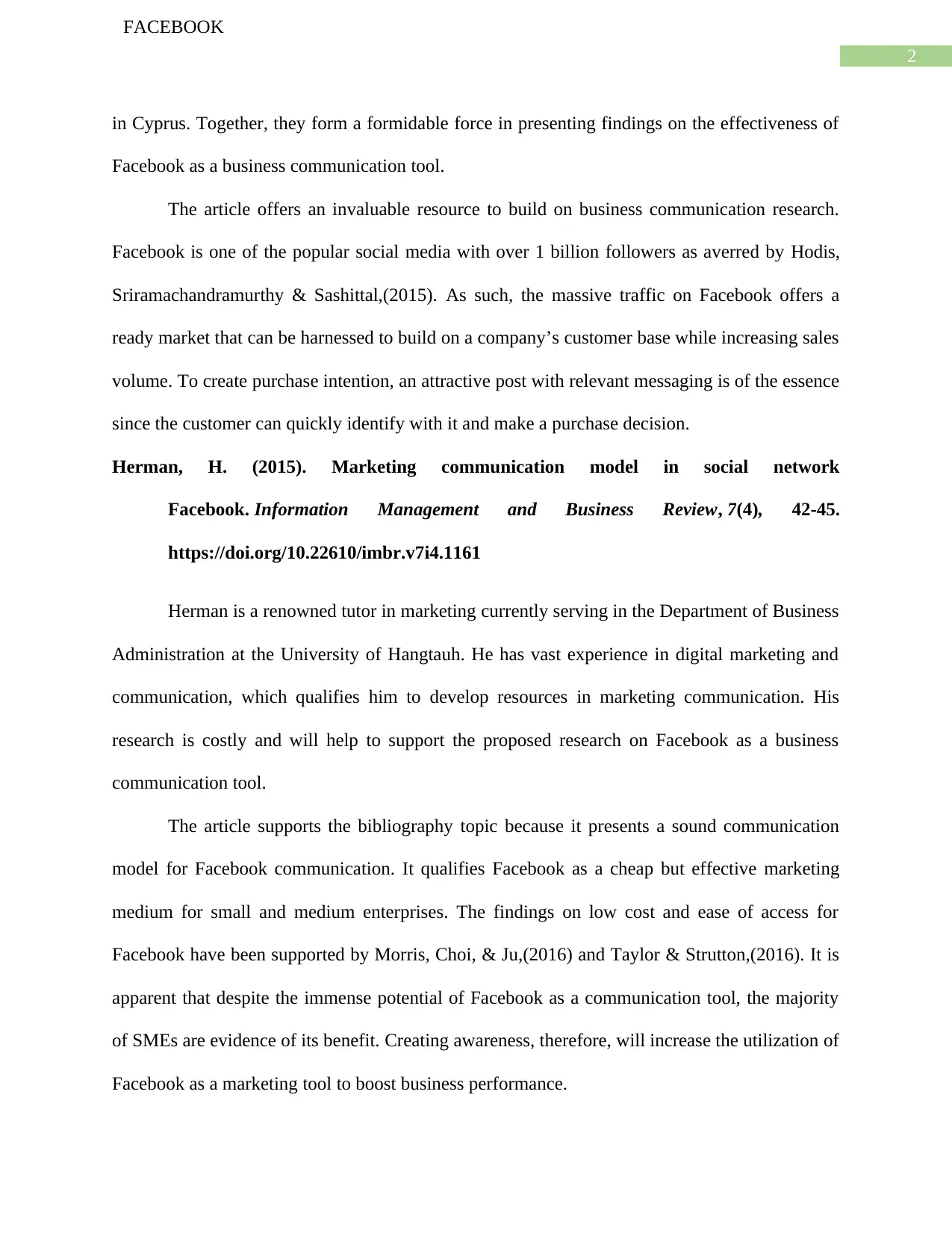
2
FACEBOOK
in Cyprus. Together, they form a formidable force in presenting findings on the effectiveness of
Facebook as a business communication tool.
The article offers an invaluable resource to build on business communication research.
Facebook is one of the popular social media with over 1 billion followers as averred by Hodis,
Sriramachandramurthy & Sashittal,(2015). As such, the massive traffic on Facebook offers a
ready market that can be harnessed to build on a company’s customer base while increasing sales
volume. To create purchase intention, an attractive post with relevant messaging is of the essence
since the customer can quickly identify with it and make a purchase decision.
Herman, H. (2015). Marketing communication model in social network
Facebook. Information Management and Business Review, 7(4), 42-45.
https://doi.org/10.22610/imbr.v7i4.1161
Herman is a renowned tutor in marketing currently serving in the Department of Business
Administration at the University of Hangtauh. He has vast experience in digital marketing and
communication, which qualifies him to develop resources in marketing communication. His
research is costly and will help to support the proposed research on Facebook as a business
communication tool.
The article supports the bibliography topic because it presents a sound communication
model for Facebook communication. It qualifies Facebook as a cheap but effective marketing
medium for small and medium enterprises. The findings on low cost and ease of access for
Facebook have been supported by Morris, Choi, & Ju,(2016) and Taylor & Strutton,(2016). It is
apparent that despite the immense potential of Facebook as a communication tool, the majority
of SMEs are evidence of its benefit. Creating awareness, therefore, will increase the utilization of
Facebook as a marketing tool to boost business performance.
in Cyprus. Together, they form a formidable force in presenting findings on the effectiveness of
Facebook as a business communication tool.
The article offers an invaluable resource to build on business communication research.
Facebook is one of the popular social media with over 1 billion followers as averred by Hodis,
Sriramachandramurthy & Sashittal,(2015). As such, the massive traffic on Facebook offers a
ready market that can be harnessed to build on a company’s customer base while increasing sales
volume. To create purchase intention, an attractive post with relevant messaging is of the essence
since the customer can quickly identify with it and make a purchase decision.
Herman, H. (2015). Marketing communication model in social network
Facebook. Information Management and Business Review, 7(4), 42-45.
https://doi.org/10.22610/imbr.v7i4.1161
Herman is a renowned tutor in marketing currently serving in the Department of Business
Administration at the University of Hangtauh. He has vast experience in digital marketing and
communication, which qualifies him to develop resources in marketing communication. His
research is costly and will help to support the proposed research on Facebook as a business
communication tool.
The article supports the bibliography topic because it presents a sound communication
model for Facebook communication. It qualifies Facebook as a cheap but effective marketing
medium for small and medium enterprises. The findings on low cost and ease of access for
Facebook have been supported by Morris, Choi, & Ju,(2016) and Taylor & Strutton,(2016). It is
apparent that despite the immense potential of Facebook as a communication tool, the majority
of SMEs are evidence of its benefit. Creating awareness, therefore, will increase the utilization of
Facebook as a marketing tool to boost business performance.
⊘ This is a preview!⊘
Do you want full access?
Subscribe today to unlock all pages.

Trusted by 1+ million students worldwide
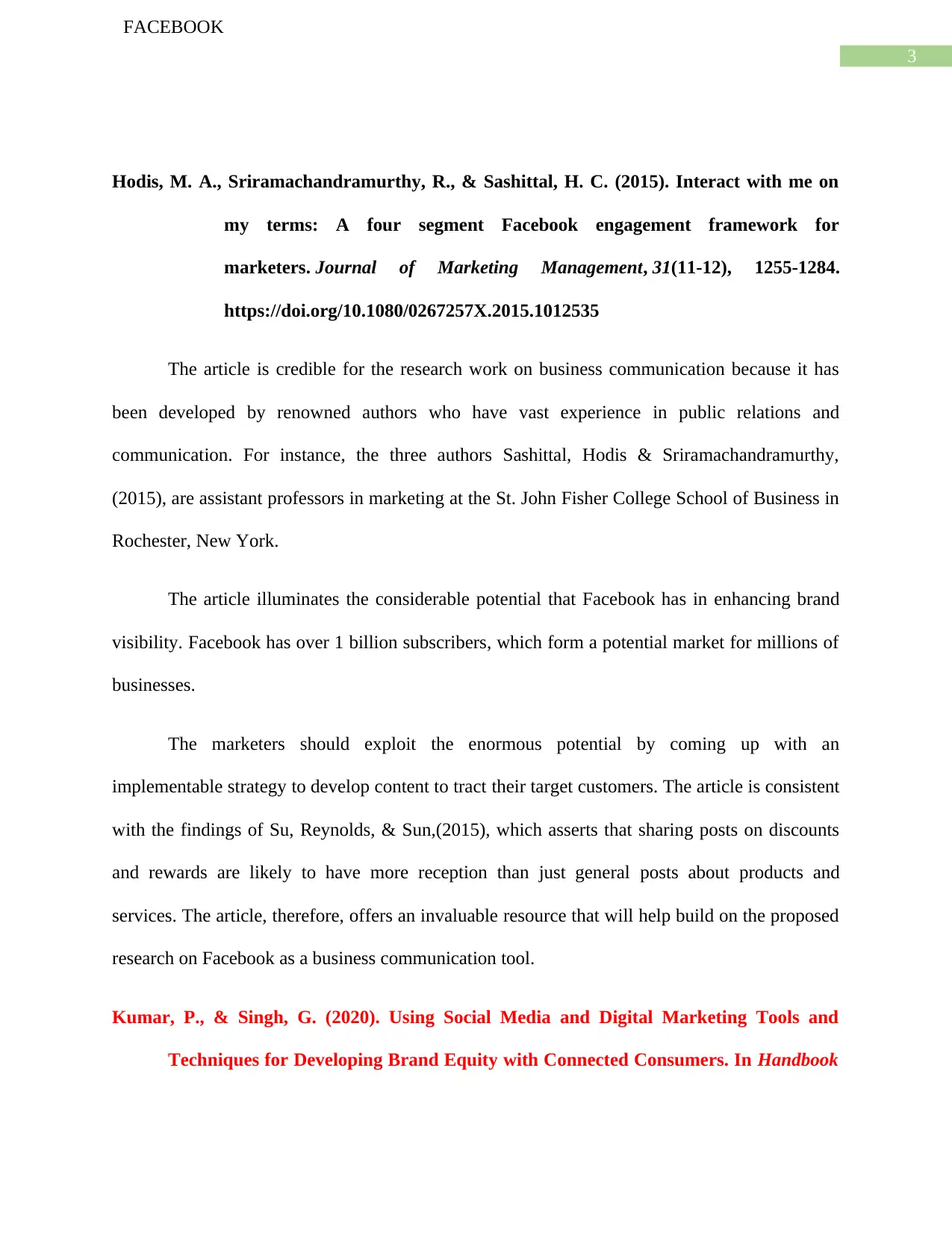
3
FACEBOOK
Hodis, M. A., Sriramachandramurthy, R., & Sashittal, H. C. (2015). Interact with me on
my terms: A four segment Facebook engagement framework for
marketers. Journal of Marketing Management, 31(11-12), 1255-1284.
https://doi.org/10.1080/0267257X.2015.1012535
The article is credible for the research work on business communication because it has
been developed by renowned authors who have vast experience in public relations and
communication. For instance, the three authors Sashittal, Hodis & Sriramachandramurthy,
(2015), are assistant professors in marketing at the St. John Fisher College School of Business in
Rochester, New York.
The article illuminates the considerable potential that Facebook has in enhancing brand
visibility. Facebook has over 1 billion subscribers, which form a potential market for millions of
businesses.
The marketers should exploit the enormous potential by coming up with an
implementable strategy to develop content to tract their target customers. The article is consistent
with the findings of Su, Reynolds, & Sun,(2015), which asserts that sharing posts on discounts
and rewards are likely to have more reception than just general posts about products and
services. The article, therefore, offers an invaluable resource that will help build on the proposed
research on Facebook as a business communication tool.
Kumar, P., & Singh, G. (2020). Using Social Media and Digital Marketing Tools and
Techniques for Developing Brand Equity with Connected Consumers. In Handbook
Hodis, M. A., Sriramachandramurthy, R., & Sashittal, H. C. (2015). Interact with me on
my terms: A four segment Facebook engagement framework for
marketers. Journal of Marketing Management, 31(11-12), 1255-1284.
https://doi.org/10.1080/0267257X.2015.1012535
The article is credible for the research work on business communication because it has
been developed by renowned authors who have vast experience in public relations and
communication. For instance, the three authors Sashittal, Hodis & Sriramachandramurthy,
(2015), are assistant professors in marketing at the St. John Fisher College School of Business in
Rochester, New York.
The article illuminates the considerable potential that Facebook has in enhancing brand
visibility. Facebook has over 1 billion subscribers, which form a potential market for millions of
businesses.
The marketers should exploit the enormous potential by coming up with an
implementable strategy to develop content to tract their target customers. The article is consistent
with the findings of Su, Reynolds, & Sun,(2015), which asserts that sharing posts on discounts
and rewards are likely to have more reception than just general posts about products and
services. The article, therefore, offers an invaluable resource that will help build on the proposed
research on Facebook as a business communication tool.
Kumar, P., & Singh, G. (2020). Using Social Media and Digital Marketing Tools and
Techniques for Developing Brand Equity with Connected Consumers. In Handbook
Paraphrase This Document
Need a fresh take? Get an instant paraphrase of this document with our AI Paraphraser
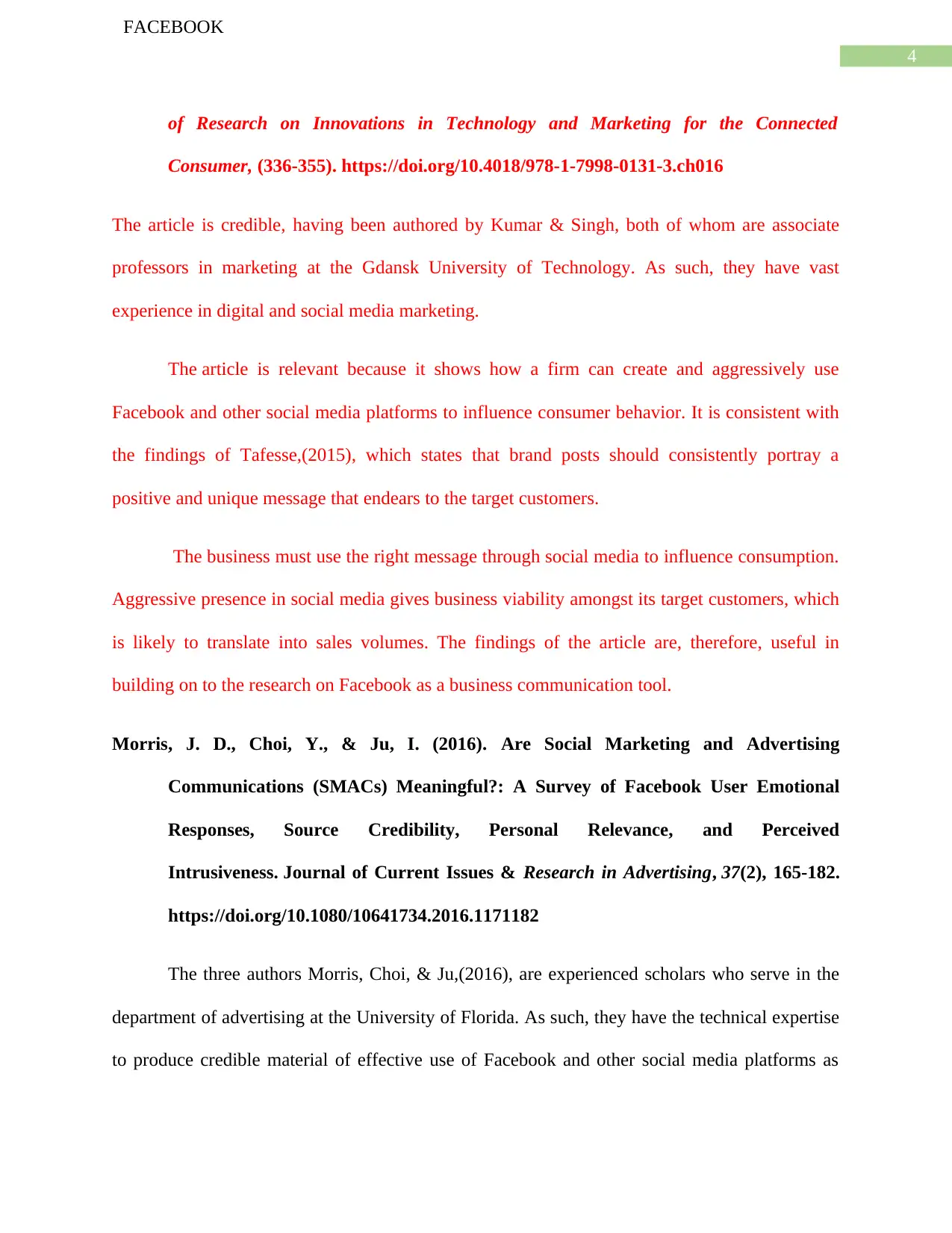
4
FACEBOOK
of Research on Innovations in Technology and Marketing for the Connected
Consumer, (336-355). https://doi.org/10.4018/978-1-7998-0131-3.ch016
The article is credible, having been authored by Kumar & Singh, both of whom are associate
professors in marketing at the Gdansk University of Technology. As such, they have vast
experience in digital and social media marketing.
The article is relevant because it shows how a firm can create and aggressively use
Facebook and other social media platforms to influence consumer behavior. It is consistent with
the findings of Tafesse,(2015), which states that brand posts should consistently portray a
positive and unique message that endears to the target customers.
The business must use the right message through social media to influence consumption.
Aggressive presence in social media gives business viability amongst its target customers, which
is likely to translate into sales volumes. The findings of the article are, therefore, useful in
building on to the research on Facebook as a business communication tool.
Morris, J. D., Choi, Y., & Ju, I. (2016). Are Social Marketing and Advertising
Communications (SMACs) Meaningful?: A Survey of Facebook User Emotional
Responses, Source Credibility, Personal Relevance, and Perceived
Intrusiveness. Journal of Current Issues & Research in Advertising, 37(2), 165-182.
https://doi.org/10.1080/10641734.2016.1171182
The three authors Morris, Choi, & Ju,(2016), are experienced scholars who serve in the
department of advertising at the University of Florida. As such, they have the technical expertise
to produce credible material of effective use of Facebook and other social media platforms as
of Research on Innovations in Technology and Marketing for the Connected
Consumer, (336-355). https://doi.org/10.4018/978-1-7998-0131-3.ch016
The article is credible, having been authored by Kumar & Singh, both of whom are associate
professors in marketing at the Gdansk University of Technology. As such, they have vast
experience in digital and social media marketing.
The article is relevant because it shows how a firm can create and aggressively use
Facebook and other social media platforms to influence consumer behavior. It is consistent with
the findings of Tafesse,(2015), which states that brand posts should consistently portray a
positive and unique message that endears to the target customers.
The business must use the right message through social media to influence consumption.
Aggressive presence in social media gives business viability amongst its target customers, which
is likely to translate into sales volumes. The findings of the article are, therefore, useful in
building on to the research on Facebook as a business communication tool.
Morris, J. D., Choi, Y., & Ju, I. (2016). Are Social Marketing and Advertising
Communications (SMACs) Meaningful?: A Survey of Facebook User Emotional
Responses, Source Credibility, Personal Relevance, and Perceived
Intrusiveness. Journal of Current Issues & Research in Advertising, 37(2), 165-182.
https://doi.org/10.1080/10641734.2016.1171182
The three authors Morris, Choi, & Ju,(2016), are experienced scholars who serve in the
department of advertising at the University of Florida. As such, they have the technical expertise
to produce credible material of effective use of Facebook and other social media platforms as
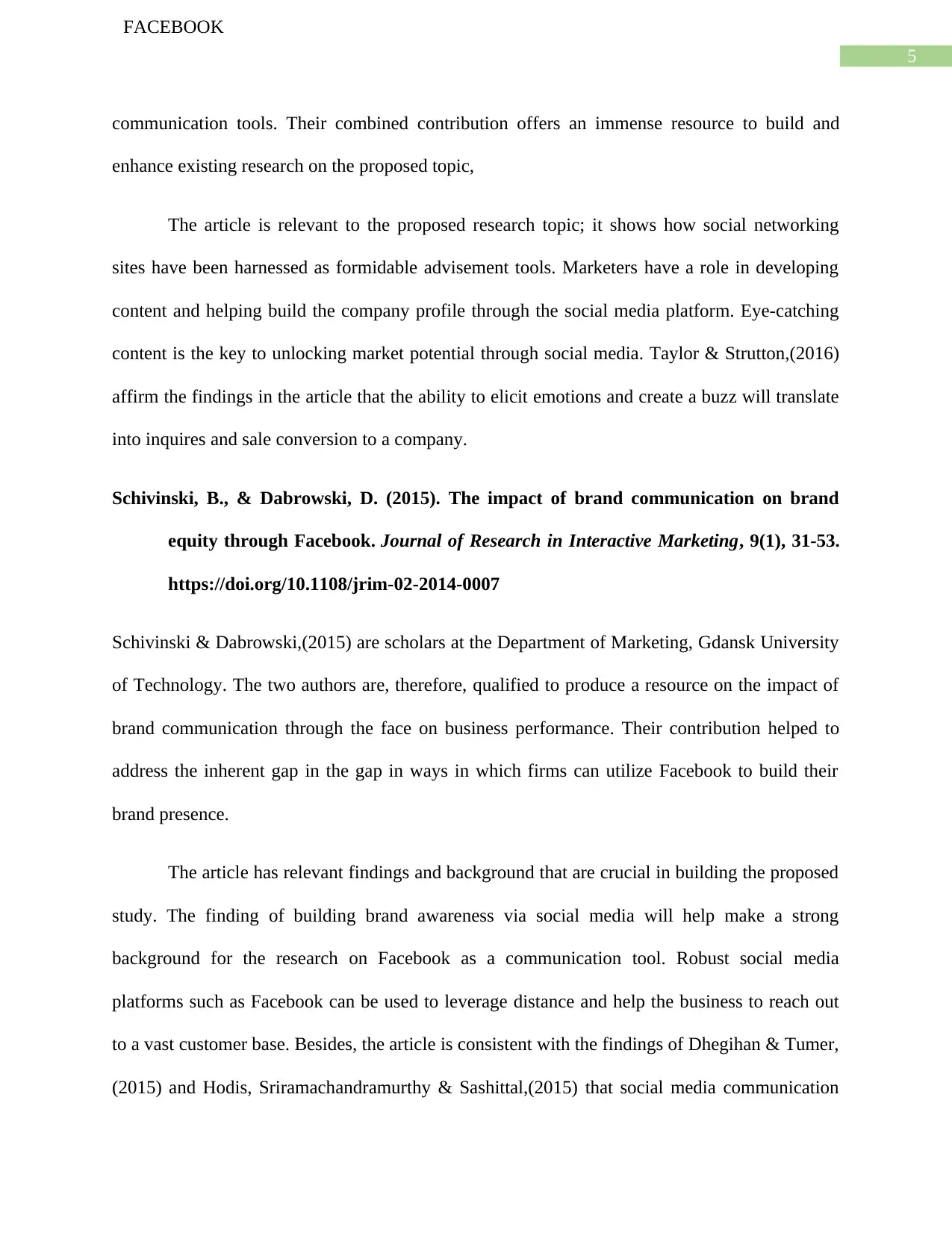
5
FACEBOOK
communication tools. Their combined contribution offers an immense resource to build and
enhance existing research on the proposed topic,
The article is relevant to the proposed research topic; it shows how social networking
sites have been harnessed as formidable advisement tools. Marketers have a role in developing
content and helping build the company profile through the social media platform. Eye-catching
content is the key to unlocking market potential through social media. Taylor & Strutton,(2016)
affirm the findings in the article that the ability to elicit emotions and create a buzz will translate
into inquires and sale conversion to a company.
Schivinski, B., & Dabrowski, D. (2015). The impact of brand communication on brand
equity through Facebook. Journal of Research in Interactive Marketing, 9(1), 31-53.
https://doi.org/10.1108/jrim-02-2014-0007
Schivinski & Dabrowski,(2015) are scholars at the Department of Marketing, Gdansk University
of Technology. The two authors are, therefore, qualified to produce a resource on the impact of
brand communication through the face on business performance. Their contribution helped to
address the inherent gap in the gap in ways in which firms can utilize Facebook to build their
brand presence.
The article has relevant findings and background that are crucial in building the proposed
study. The finding of building brand awareness via social media will help make a strong
background for the research on Facebook as a communication tool. Robust social media
platforms such as Facebook can be used to leverage distance and help the business to reach out
to a vast customer base. Besides, the article is consistent with the findings of Dhegihan & Tumer,
(2015) and Hodis, Sriramachandramurthy & Sashittal,(2015) that social media communication
communication tools. Their combined contribution offers an immense resource to build and
enhance existing research on the proposed topic,
The article is relevant to the proposed research topic; it shows how social networking
sites have been harnessed as formidable advisement tools. Marketers have a role in developing
content and helping build the company profile through the social media platform. Eye-catching
content is the key to unlocking market potential through social media. Taylor & Strutton,(2016)
affirm the findings in the article that the ability to elicit emotions and create a buzz will translate
into inquires and sale conversion to a company.
Schivinski, B., & Dabrowski, D. (2015). The impact of brand communication on brand
equity through Facebook. Journal of Research in Interactive Marketing, 9(1), 31-53.
https://doi.org/10.1108/jrim-02-2014-0007
Schivinski & Dabrowski,(2015) are scholars at the Department of Marketing, Gdansk University
of Technology. The two authors are, therefore, qualified to produce a resource on the impact of
brand communication through the face on business performance. Their contribution helped to
address the inherent gap in the gap in ways in which firms can utilize Facebook to build their
brand presence.
The article has relevant findings and background that are crucial in building the proposed
study. The finding of building brand awareness via social media will help make a strong
background for the research on Facebook as a communication tool. Robust social media
platforms such as Facebook can be used to leverage distance and help the business to reach out
to a vast customer base. Besides, the article is consistent with the findings of Dhegihan & Tumer,
(2015) and Hodis, Sriramachandramurthy & Sashittal,(2015) that social media communication
⊘ This is a preview!⊘
Do you want full access?
Subscribe today to unlock all pages.

Trusted by 1+ million students worldwide
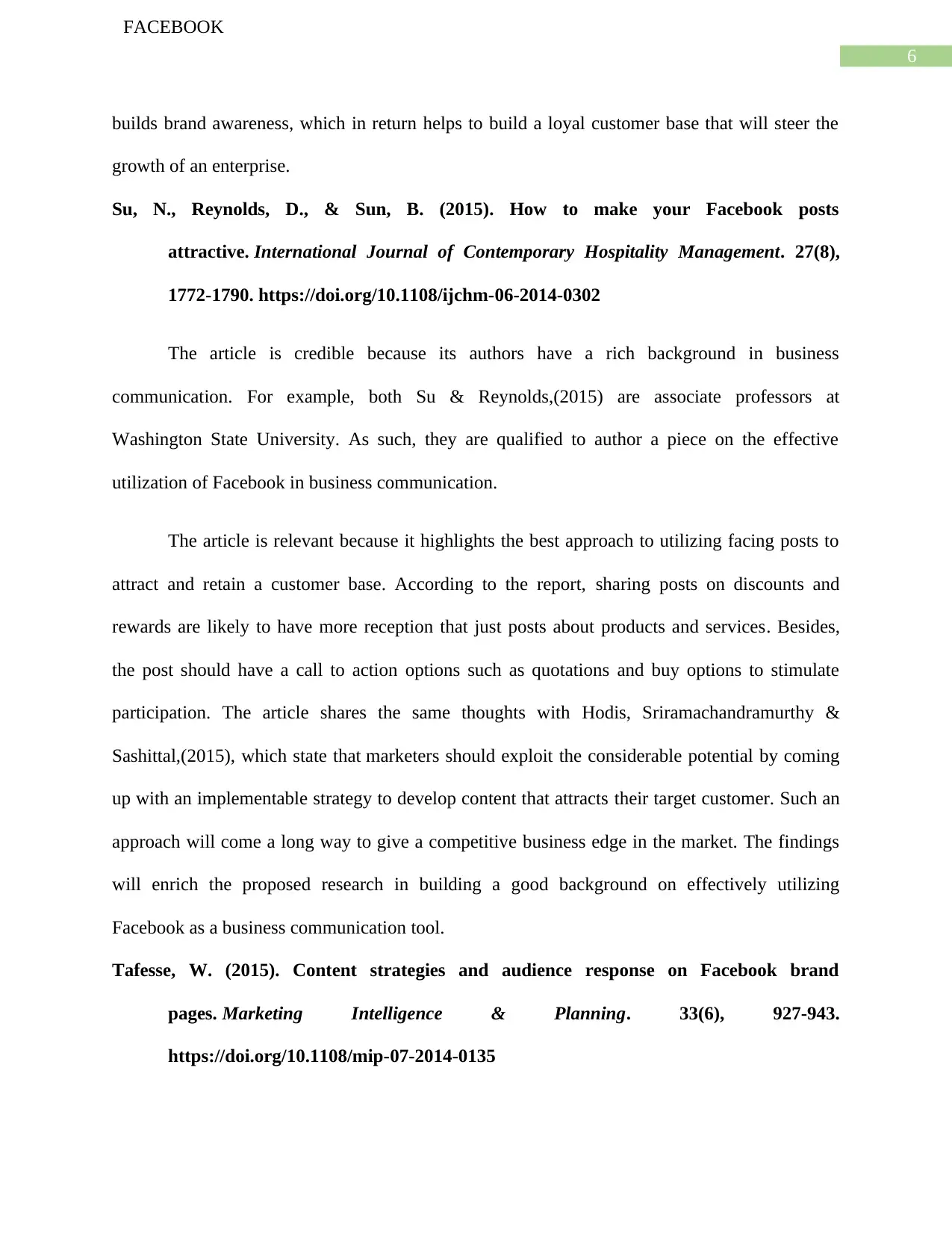
6
FACEBOOK
builds brand awareness, which in return helps to build a loyal customer base that will steer the
growth of an enterprise.
Su, N., Reynolds, D., & Sun, B. (2015). How to make your Facebook posts
attractive. International Journal of Contemporary Hospitality Management. 27(8),
1772-1790. https://doi.org/10.1108/ijchm-06-2014-0302
The article is credible because its authors have a rich background in business
communication. For example, both Su & Reynolds,(2015) are associate professors at
Washington State University. As such, they are qualified to author a piece on the effective
utilization of Facebook in business communication.
The article is relevant because it highlights the best approach to utilizing facing posts to
attract and retain a customer base. According to the report, sharing posts on discounts and
rewards are likely to have more reception that just posts about products and services. Besides,
the post should have a call to action options such as quotations and buy options to stimulate
participation. The article shares the same thoughts with Hodis, Sriramachandramurthy &
Sashittal,(2015), which state that marketers should exploit the considerable potential by coming
up with an implementable strategy to develop content that attracts their target customer. Such an
approach will come a long way to give a competitive business edge in the market. The findings
will enrich the proposed research in building a good background on effectively utilizing
Facebook as a business communication tool.
Tafesse, W. (2015). Content strategies and audience response on Facebook brand
pages. Marketing Intelligence & Planning. 33(6), 927-943.
https://doi.org/10.1108/mip-07-2014-0135
builds brand awareness, which in return helps to build a loyal customer base that will steer the
growth of an enterprise.
Su, N., Reynolds, D., & Sun, B. (2015). How to make your Facebook posts
attractive. International Journal of Contemporary Hospitality Management. 27(8),
1772-1790. https://doi.org/10.1108/ijchm-06-2014-0302
The article is credible because its authors have a rich background in business
communication. For example, both Su & Reynolds,(2015) are associate professors at
Washington State University. As such, they are qualified to author a piece on the effective
utilization of Facebook in business communication.
The article is relevant because it highlights the best approach to utilizing facing posts to
attract and retain a customer base. According to the report, sharing posts on discounts and
rewards are likely to have more reception that just posts about products and services. Besides,
the post should have a call to action options such as quotations and buy options to stimulate
participation. The article shares the same thoughts with Hodis, Sriramachandramurthy &
Sashittal,(2015), which state that marketers should exploit the considerable potential by coming
up with an implementable strategy to develop content that attracts their target customer. Such an
approach will come a long way to give a competitive business edge in the market. The findings
will enrich the proposed research in building a good background on effectively utilizing
Facebook as a business communication tool.
Tafesse, W. (2015). Content strategies and audience response on Facebook brand
pages. Marketing Intelligence & Planning. 33(6), 927-943.
https://doi.org/10.1108/mip-07-2014-0135
Paraphrase This Document
Need a fresh take? Get an instant paraphrase of this document with our AI Paraphraser
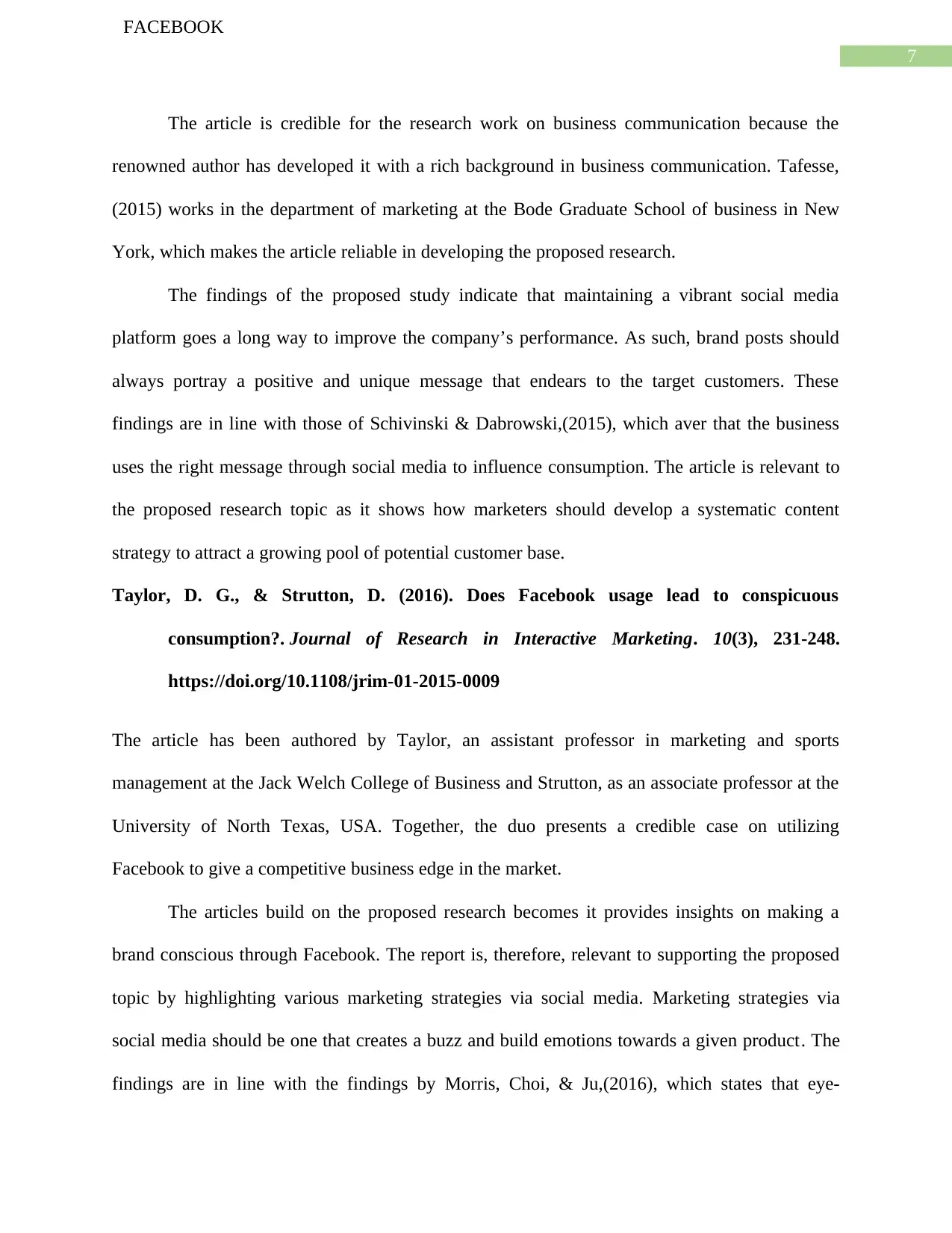
7
FACEBOOK
The article is credible for the research work on business communication because the
renowned author has developed it with a rich background in business communication. Tafesse,
(2015) works in the department of marketing at the Bode Graduate School of business in New
York, which makes the article reliable in developing the proposed research.
The findings of the proposed study indicate that maintaining a vibrant social media
platform goes a long way to improve the company’s performance. As such, brand posts should
always portray a positive and unique message that endears to the target customers. These
findings are in line with those of Schivinski & Dabrowski,(2015), which aver that the business
uses the right message through social media to influence consumption. The article is relevant to
the proposed research topic as it shows how marketers should develop a systematic content
strategy to attract a growing pool of potential customer base.
Taylor, D. G., & Strutton, D. (2016). Does Facebook usage lead to conspicuous
consumption?. Journal of Research in Interactive Marketing. 10(3), 231-248.
https://doi.org/10.1108/jrim-01-2015-0009
The article has been authored by Taylor, an assistant professor in marketing and sports
management at the Jack Welch College of Business and Strutton, as an associate professor at the
University of North Texas, USA. Together, the duo presents a credible case on utilizing
Facebook to give a competitive business edge in the market.
The articles build on the proposed research becomes it provides insights on making a
brand conscious through Facebook. The report is, therefore, relevant to supporting the proposed
topic by highlighting various marketing strategies via social media. Marketing strategies via
social media should be one that creates a buzz and build emotions towards a given product. The
findings are in line with the findings by Morris, Choi, & Ju,(2016), which states that eye-
The article is credible for the research work on business communication because the
renowned author has developed it with a rich background in business communication. Tafesse,
(2015) works in the department of marketing at the Bode Graduate School of business in New
York, which makes the article reliable in developing the proposed research.
The findings of the proposed study indicate that maintaining a vibrant social media
platform goes a long way to improve the company’s performance. As such, brand posts should
always portray a positive and unique message that endears to the target customers. These
findings are in line with those of Schivinski & Dabrowski,(2015), which aver that the business
uses the right message through social media to influence consumption. The article is relevant to
the proposed research topic as it shows how marketers should develop a systematic content
strategy to attract a growing pool of potential customer base.
Taylor, D. G., & Strutton, D. (2016). Does Facebook usage lead to conspicuous
consumption?. Journal of Research in Interactive Marketing. 10(3), 231-248.
https://doi.org/10.1108/jrim-01-2015-0009
The article has been authored by Taylor, an assistant professor in marketing and sports
management at the Jack Welch College of Business and Strutton, as an associate professor at the
University of North Texas, USA. Together, the duo presents a credible case on utilizing
Facebook to give a competitive business edge in the market.
The articles build on the proposed research becomes it provides insights on making a
brand conscious through Facebook. The report is, therefore, relevant to supporting the proposed
topic by highlighting various marketing strategies via social media. Marketing strategies via
social media should be one that creates a buzz and build emotions towards a given product. The
findings are in line with the findings by Morris, Choi, & Ju,(2016), which states that eye-
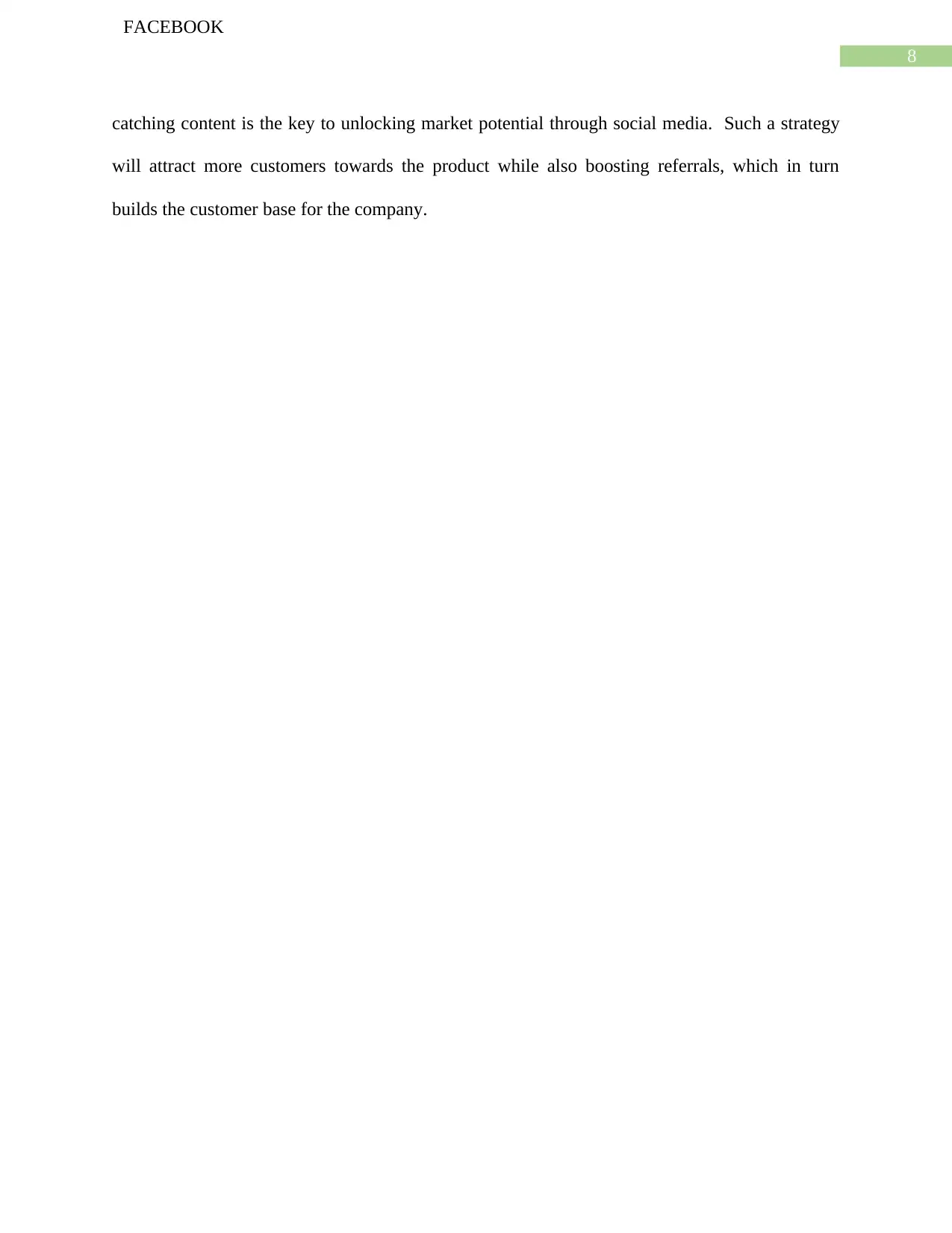
8
FACEBOOK
catching content is the key to unlocking market potential through social media. Such a strategy
will attract more customers towards the product while also boosting referrals, which in turn
builds the customer base for the company.
catching content is the key to unlocking market potential through social media. Such a strategy
will attract more customers towards the product while also boosting referrals, which in turn
builds the customer base for the company.
⊘ This is a preview!⊘
Do you want full access?
Subscribe today to unlock all pages.

Trusted by 1+ million students worldwide
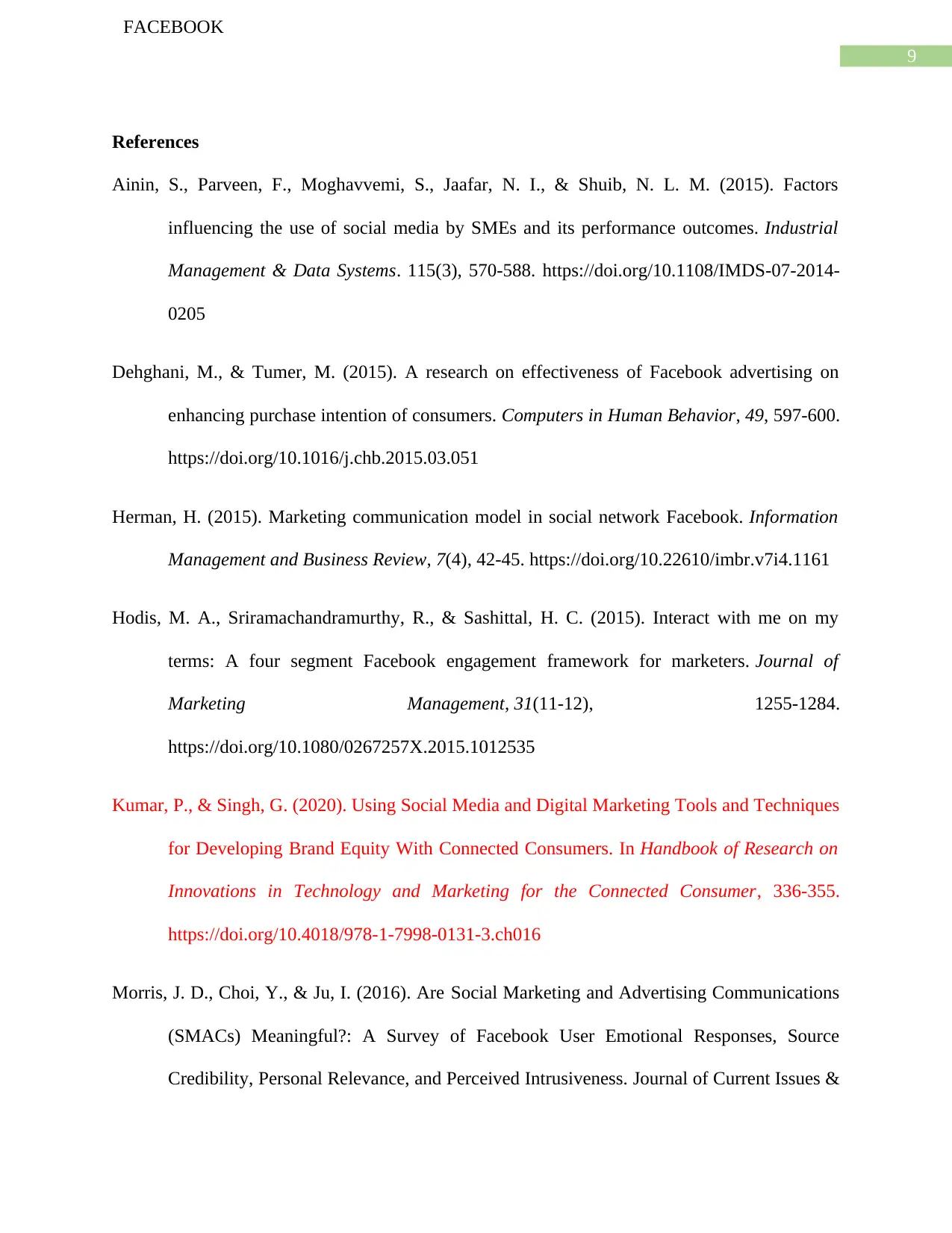
9
FACEBOOK
References
Ainin, S., Parveen, F., Moghavvemi, S., Jaafar, N. I., & Shuib, N. L. M. (2015). Factors
influencing the use of social media by SMEs and its performance outcomes. Industrial
Management & Data Systems. 115(3), 570-588. https://doi.org/10.1108/IMDS-07-2014-
0205
Dehghani, M., & Tumer, M. (2015). A research on effectiveness of Facebook advertising on
enhancing purchase intention of consumers. Computers in Human Behavior, 49, 597-600.
https://doi.org/10.1016/j.chb.2015.03.051
Herman, H. (2015). Marketing communication model in social network Facebook. Information
Management and Business Review, 7(4), 42-45. https://doi.org/10.22610/imbr.v7i4.1161
Hodis, M. A., Sriramachandramurthy, R., & Sashittal, H. C. (2015). Interact with me on my
terms: A four segment Facebook engagement framework for marketers. Journal of
Marketing Management, 31(11-12), 1255-1284.
https://doi.org/10.1080/0267257X.2015.1012535
Kumar, P., & Singh, G. (2020). Using Social Media and Digital Marketing Tools and Techniques
for Developing Brand Equity With Connected Consumers. In Handbook of Research on
Innovations in Technology and Marketing for the Connected Consumer, 336-355.
https://doi.org/10.4018/978-1-7998-0131-3.ch016
Morris, J. D., Choi, Y., & Ju, I. (2016). Are Social Marketing and Advertising Communications
(SMACs) Meaningful?: A Survey of Facebook User Emotional Responses, Source
Credibility, Personal Relevance, and Perceived Intrusiveness. Journal of Current Issues &
References
Ainin, S., Parveen, F., Moghavvemi, S., Jaafar, N. I., & Shuib, N. L. M. (2015). Factors
influencing the use of social media by SMEs and its performance outcomes. Industrial
Management & Data Systems. 115(3), 570-588. https://doi.org/10.1108/IMDS-07-2014-
0205
Dehghani, M., & Tumer, M. (2015). A research on effectiveness of Facebook advertising on
enhancing purchase intention of consumers. Computers in Human Behavior, 49, 597-600.
https://doi.org/10.1016/j.chb.2015.03.051
Herman, H. (2015). Marketing communication model in social network Facebook. Information
Management and Business Review, 7(4), 42-45. https://doi.org/10.22610/imbr.v7i4.1161
Hodis, M. A., Sriramachandramurthy, R., & Sashittal, H. C. (2015). Interact with me on my
terms: A four segment Facebook engagement framework for marketers. Journal of
Marketing Management, 31(11-12), 1255-1284.
https://doi.org/10.1080/0267257X.2015.1012535
Kumar, P., & Singh, G. (2020). Using Social Media and Digital Marketing Tools and Techniques
for Developing Brand Equity With Connected Consumers. In Handbook of Research on
Innovations in Technology and Marketing for the Connected Consumer, 336-355.
https://doi.org/10.4018/978-1-7998-0131-3.ch016
Morris, J. D., Choi, Y., & Ju, I. (2016). Are Social Marketing and Advertising Communications
(SMACs) Meaningful?: A Survey of Facebook User Emotional Responses, Source
Credibility, Personal Relevance, and Perceived Intrusiveness. Journal of Current Issues &
Paraphrase This Document
Need a fresh take? Get an instant paraphrase of this document with our AI Paraphraser
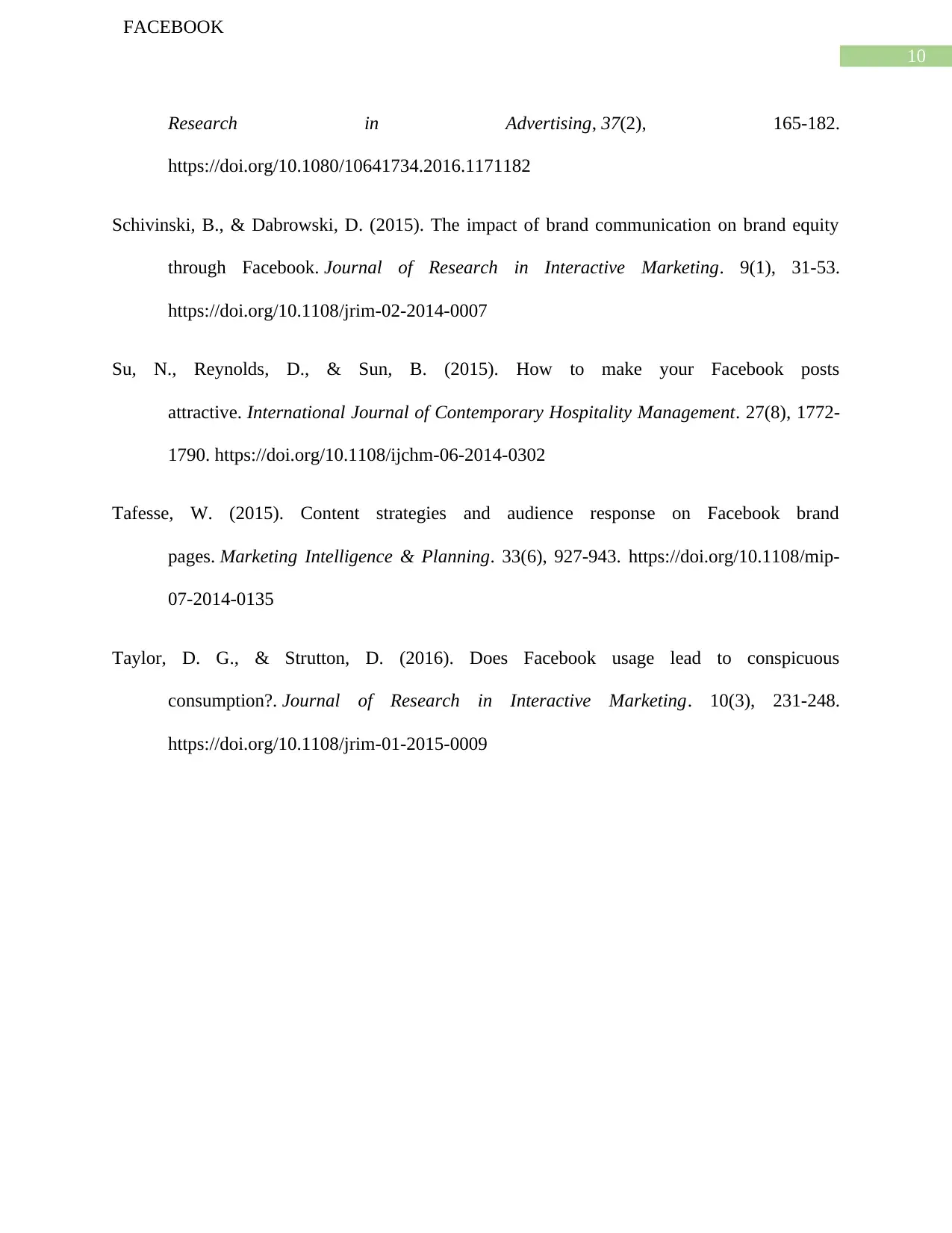
10
FACEBOOK
Research in Advertising, 37(2), 165-182.
https://doi.org/10.1080/10641734.2016.1171182
Schivinski, B., & Dabrowski, D. (2015). The impact of brand communication on brand equity
through Facebook. Journal of Research in Interactive Marketing. 9(1), 31-53.
https://doi.org/10.1108/jrim-02-2014-0007
Su, N., Reynolds, D., & Sun, B. (2015). How to make your Facebook posts
attractive. International Journal of Contemporary Hospitality Management. 27(8), 1772-
1790. https://doi.org/10.1108/ijchm-06-2014-0302
Tafesse, W. (2015). Content strategies and audience response on Facebook brand
pages. Marketing Intelligence & Planning. 33(6), 927-943. https://doi.org/10.1108/mip-
07-2014-0135
Taylor, D. G., & Strutton, D. (2016). Does Facebook usage lead to conspicuous
consumption?. Journal of Research in Interactive Marketing. 10(3), 231-248.
https://doi.org/10.1108/jrim-01-2015-0009
Research in Advertising, 37(2), 165-182.
https://doi.org/10.1080/10641734.2016.1171182
Schivinski, B., & Dabrowski, D. (2015). The impact of brand communication on brand equity
through Facebook. Journal of Research in Interactive Marketing. 9(1), 31-53.
https://doi.org/10.1108/jrim-02-2014-0007
Su, N., Reynolds, D., & Sun, B. (2015). How to make your Facebook posts
attractive. International Journal of Contemporary Hospitality Management. 27(8), 1772-
1790. https://doi.org/10.1108/ijchm-06-2014-0302
Tafesse, W. (2015). Content strategies and audience response on Facebook brand
pages. Marketing Intelligence & Planning. 33(6), 927-943. https://doi.org/10.1108/mip-
07-2014-0135
Taylor, D. G., & Strutton, D. (2016). Does Facebook usage lead to conspicuous
consumption?. Journal of Research in Interactive Marketing. 10(3), 231-248.
https://doi.org/10.1108/jrim-01-2015-0009

11
FACEBOOK
⊘ This is a preview!⊘
Do you want full access?
Subscribe today to unlock all pages.

Trusted by 1+ million students worldwide
1 out of 12
Related Documents
Your All-in-One AI-Powered Toolkit for Academic Success.
+13062052269
info@desklib.com
Available 24*7 on WhatsApp / Email
![[object Object]](/_next/static/media/star-bottom.7253800d.svg)
Unlock your academic potential
Copyright © 2020–2025 A2Z Services. All Rights Reserved. Developed and managed by ZUCOL.




